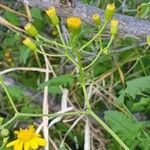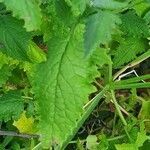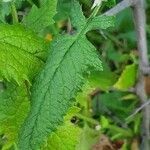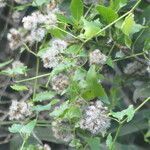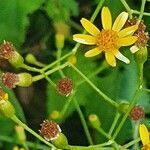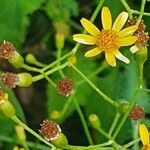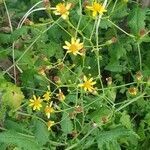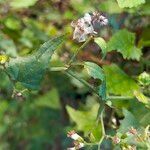A much-branched slender herbaceous scrambler, the internodes, including those of the inflorescence branches, markedly zigzag, stems and leaves glabrous to thinly and minutely pubescent. Leaves up to 8 x 7 cm but often only half that size, deltoid to deltoid-hastate, apex acute to acuminate, base more or less cordate to truncate, margin irregularly dentate or denticulate, petioles one third to half the length of the blade, often auricled at the base. Heads discoid or rayed, many in divaricate corymbose-panicles terminating the branchlet or short axillary peduncles. Involucre turbinate, bracts 5-8, 3-4 mm long, a little shorter than the disc, swollen at the base, nerves resinous, calyculus bracts few, short. Rays, when present, 1(-4), they and the disc bright yellow, corolla lobes of disc flowers each with a median resinous line. Achenes 2 mm long, cylindric, ribbed, hispid between the ribs.
Perennial, herbaceous scrambler, glabrous to ± pubescent. Stems slender, internodes zigzag, ± glabrous, up to 2.5 m long. Leaves deltoid to deltoid-hastate, up to 80 mm long, base ± cordate, margins dentate or denticulate; petioles ± 30-40 mm long, base often auricled. Inflorescence a branched, corymbose panicle, terminating branchlets. Capitula discoid, bright yellow; involucre turbinate; bracts 5-8, 3-4 mm long; calyculus bracts few, short. Flowering time Apr.-July. Cypselae cylindrical, 2 mm long, ribbed, furrows hispid.
Herbaceous scrambler. Ultimate branchlets zigzag. Leaves deltoid to deltoid-hastate, margins irregularly dentate or denticulate. Heads discoid or radiate. Involucral bracts 5-8, 3-4 mm long. Flowers bright yellow; March to April and July to September.
A herb. It keeps growing from year to year. The stems grow 2-7 m long. They are green, ribbed and finely hairy. The leaves are D shaped and have teeth along the edge. The flowers are yellow.
Soft-leaved climber with zigzag branching. Leaves deltoid, petiolate, eared at base, toothed. Flower heads discoid, in corymbose panicles, orange or yellow, bracts 5.
